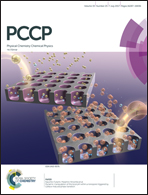Photoinduced structural distortions and singlet–triplet intersystem crossing in Cu(i) MLCT excited states monitored by optically gated fluorescence spectroscopy†
Abstract
Copper(I) phenanthroline complexes represent viable earth-abundant alternatives to the ubiquitous Ru(II) tris-bipyridine photosensitizers owing to their similar metal-to-ligand charge transfer (MLCT) properties. A well-established complication of Cu(I) phenanthroline complexes is that they can undergo significant photo-induced structural rearrangements, leading to excited states that are highly susceptible to exciplex formation and short-lived. In this work, a comprehensive analysis of the photo-induced structural distortions and singlet–triplet intersystem crossing dynamics of a series of four sterically encumbered Cu(I) phenanthroline chromophores has been conducted, namely, [Cu(dsbp)2]+ (dsbp = 2,9-di-sec-butyl-1,10-phenanthroline), [Cu(dsbtmp)2]+ (dsbtmp = 2,9-di-sec-butyl-3,4,7,8-tetramethyl-1,10-phenanthroline), [Cu(dipp)2]+ (dipp = 2,9-di-isopropyl-1,10-phenanthroline), and [Cu(diptmp)2]+ (diptmp = 2,9-di-isopropyl-3,4,7,8-tetramethyl-1,10-phenanthroline). Upconverted fluorescence decay kinetics were measured at wavelengths along the blue side of the photoluminescence spectrum. The experimental results displayed strong wavelength dependence of the singlet emission, with rapid sub-picosecond decay dominating at higher energies. At lower emission energies, increasing contribution of a longer decay component was revealed. This wavelength dependence is a signature of the excited state structural rearrangement of the phenanthroline ligands which concomitantly lower the excited state energy. The obtained time constants were in excellent agreement with those measured in the complementary ultrafast transient absorption experiments. The sub-picosecond component (prompt fluorescence) is associated with the photo-induced structural rearrangement that lowers the energy of the singlet excited state. The longer decay component represents the lifetime of the S1 excited state, and thus the time-scale of singlet–triplet intersystem crossing. Lastly, the observed dual emission was further characterized by constructing picosecond time-resolved emission spectra from the measured kinetic data. These qualitative luminescence spectra capture the resulting emission from both the S1 initial state and the S1 flattened state, providing further insight into the energy-lowering excited state distortion across the series.



 Please wait while we load your content...
Please wait while we load your content...